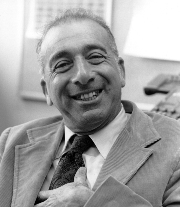Berni Alder
Berni Julian Alder | |
|---|---|
 | |
| Born | September 9, 1925[1] |
| Died | September 7, 2020(aged 94)[2] |
| Nationality | American |
| Alma mater | |
| Known for | Molecular dynamics simulation |
| Awards |
|
| Scientific career | |
| Fields | Statistical mechanics |
| Institutions | |
| Thesis | The Radial Distribution Function and the Thermodynamic Properties of Monatomic Liquids(1952) |
| Doctoral advisor | John Gamble Kirkwood |
Berni Julian Alder(September 9, 1925 – September 7, 2020) was a German-born Americanphysicistspecialized instatistical mechanics,and a pioneer of computational modelling of matter.[3]
Biography[edit]
Alder was born inDuisburg,Prussia, in September 1925, to Jewish parents, achemistand a homemaker.[4]After theNaziscame to power, the family moved toZurich,Switzerland. Fearing an invasion by Nazi Germany after the outbreak ofWorld War II,the family applied for a visa to the United States, which was granted in 1941.[4]They left by sealed train from neutral Switzerland to (formally neutral) Spain, then to Portugal, where they took a ship to the US.[4]Following a stint in the US Navy after US entry into the war, he obtained a BSc in chemistry from theUniversity of California at Berkeleyand a master's degree in chemical engineering from the same institution in 1947. He went to theCalifornia Institute of Technology[4]to study underJohn Gamble Kirkwoodfor his PhD in 1948 and worked for the investigation of phase transitions in hard-sphere gas withStan Frankel,where he got the idea to use theMonte Carlo method.After he finished at Caltech in 1952, he went to Berkeley and worked part-time at Berkeley to teach chemistry and part-time as a consultant under the suggestion ofEdward Tellerin the nuclear weapons program for theLawrence Livermore National Laboratoryto help with the equations of state. In collaboration with Thomas Everett Wainwright, andMary Ann Mansigh,he developed techniques formolecular dynamics simulationin the mid-1950s,[5]including the liquid-solid phase transition for hard sphere[6]and the velocity autocorrelations function decay in liquids.[7][8]
Alder, along with Teller, was one of the founders of theDepartment of Applied Sciencein 1963.[9]He was a professor of applied science at theUniversity of California at Davis,and later professor emeritus.
In 2001, he was awarded theBoltzmann Medalfor inventing technique of molecular dynamics simulation.
He was elected a Fellow of theAmerican Academy of Arts and Sciencesin 2008.[10]In 2009, he was awarded theNational Medal of Science.[11]
Alder was aGuggenheim Fellow.He was the editor of the book series Methods in Computational Physics and the founder of the magazine Computing.
Alder died on September 7, 2020, ofheart failure.[2]
References[edit]
- ^Sleezman, Elizabeth, ed. (2004).The International Who's Who 2004.England: Europa Publications. p.26.ISBN1857432177.
- ^abBerni Alder obituary
- ^Ceperley, David (2020-10-08). "Berni Alder (1925–2020)".Nature.586(7829): 356.Bibcode:2020Natur.586..356C.doi:10.1038/d41586-020-02858-5.
- ^abcd"Interview with Berni J. Alder"(PDF).CECAM.Retrieved10 October2022.
- ^Alder, B. J.; Wainwright, T. E. (1959). "Studies in Molecular Dynamics. I. General Method".Journal of Chemical Physics.31(2): 459.Bibcode:1959JChPh..31..459A.doi:10.1063/1.1730376.
- ^B. J. Alder and T. E. Wainwright (1957). "Phase Transition for a Hard Sphere System".J. Chem. Phys.27(5): 1208–1209.Bibcode:1957JChPh..27.1208A.doi:10.1063/1.1743957.
- ^B. J. Alder and T. E. Wainwright (1962). "Phase Transition in Elastic Disks".Phys. Rev.127(2): 359–361.Bibcode:1962PhRv..127..359A.doi:10.1103/PhysRev.127.359.
- ^B. J. Alder and T. E. Wainwright (1970). "Decay of the Velocity Autocorrelation Function".Phys. Rev. A.1(1): 18–21.Bibcode:1970PhRvA...1...18A.doi:10.1103/PhysRevA.1.18.
- ^"UCD professor emeritus to receive National Medal of Science at White House next month".Davis Enterprise. September 22, 2009.RetrievedJanuary 13,2013.
- ^"Book of Members, 1780-2010: Chapter A"(PDF).American Academy of Arts and Sciences.Retrieved14 April2011.
- ^"Berni Alder receives National Medal of Science".Lawrence Livermore National Laboratory. 2009-09-18. Archived fromthe originalon 2010-05-27.Retrieved2010-02-12.
External links[edit]
- An Interview with Bernie Alder by George Michael, Stories of the Development of Large Scale Scientific Computing at Lawrence Livermore National Laboratory
- Berni J. Alder CECAM Prize
- Oral History interview transcript for Berni Alder on 18 June 1990, American Institute of Physics, Niels Bohr Library and Archives
- 1925 births
- 2020 deaths
- 21st-century American physicists
- American people of German-Jewish descent
- California Institute of Technology alumni
- Fellows of the American Academy of Arts and Sciences
- Fellows of the American Physical Society
- Jewish emigrants from Nazi Germany to the United States
- Lawrence Livermore National Laboratory staff
- Members of the United States National Academy of Sciences
- National Medal of Science laureates
- Scientific computing researchers
- UC Berkeley College of Chemistry alumni
- University of California, Berkeley College of Letters and Science faculty
- University of California, Davis faculty
- German emigrants to Switzerland
